

Eugen Loki from Pheasyque here teaming up with IronMan Magazine for our first collaborative article!
Today, we’ll be covering the science behind a strategic approach to your training comeback following a period of detraining. We want you to use this article as a guide to get you back to your previous strength levels and size as quickly as possible.
First, let us go over the theory of muscle building, muscle loss, and muscle regaining, and the second part will focus on practical tips that you can start applying right away.
Losses in both strength and mass can vary greatly from lifter to lifter. Â Individual factors that can influence strength and mass losses include things like:
- Diet, Lifestyle
- Age
- Training history
- Training age
- Sex,
- Cessation from training
- Change in stimulus
- Injury.
Life can be hectic at times, and when we’re not able to dedicate ourselves to our fitness goals the way we would like to, then we can end up losing strength and muscle as a result.
What should we do? Before we dive into the game plan, let’s first address what happens when we gain muscle.
When we lift weights regularly, our body starts being exposed to different stimuli that result in new adaptations taking place as a response, both internally and externally.
Generally speaking, depending on how long we’ve been training, we experience:
- Improved coordination (we become more efficient at performing a task)
- Increased rate coding (our central nervous system becomes faster at recruiting the muscles needed for the task)
- Heightened motor unit recruitment (our CNS is able to tap into higher threshold muscle fibers through higher levels of effort)
There are also other adaptations that take place too, yes, but for the sake of brevity, we’ll focus on these major ones.
What Happens After We Stop Training?
While growing muscle mass is certainly a tedious and long process that takes many, many years. Losing it, on the other hand, happens rather quickly.
In fact, according to research, we can begin to see losses in muscle mass maximal strength, and power in as little as three weeks. These losses are partly due to muscle fibers atrophying and muscle fibers not being recruited to the same extent.
What Happens When We Start Re-Training?
Fortunately for us, re-gaining muscle is much easier to do than building it for the very first time. This process is called “Muscle Memory”
Human Muscle fibers possess an epigenetic memory and are actually able to remember what their previous size was. This memory allows for a quicker regaining timeframe, which is much shorter than we may assume.
In addition to our muscles have the capability of remembering previous states, our Central Nervous System (CNS) also has the capability of rebounding quickly. After years of practice, our neuromuscular nervous system becomes more efficient at performing exercises, which also helps us regain strength. We don’t need to re-learn the movements from scratch. Because of these reasons, it is much easier for our muscle fibers to return to a size they had previously obtained, even after a long period of time.
How should we train and eat during a re-training phase?
When getting back to our training, it can be imperative to play it safe and start with lower intensities than what we generally think we need. I know that you may feel very excited to lift heavy again, but remember, patience is key during this period especially to avoid injuries and burn out. With that said, here are some cool Pheasyque infographics and general guidelines that you can use to kickstart your training and nutritional program in the next following weeks.
How you should approach your training during your comeback:
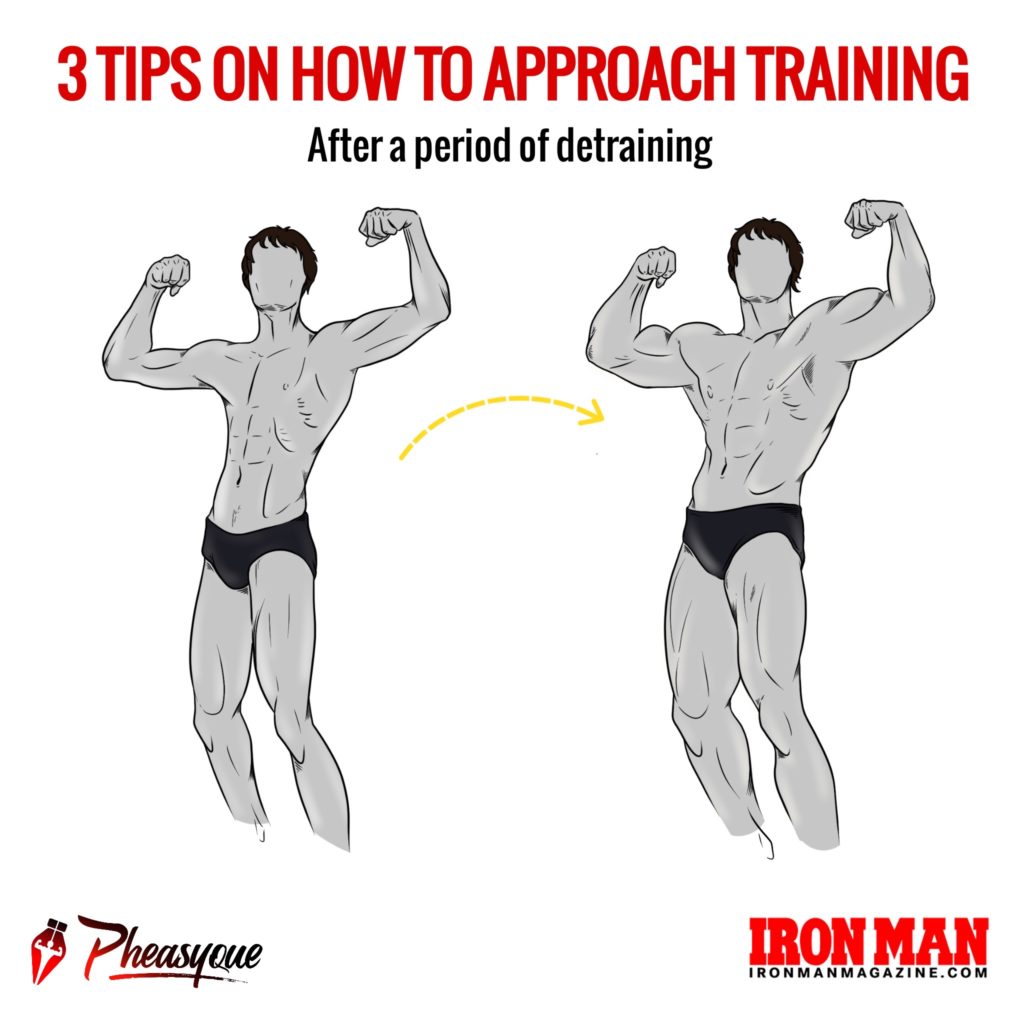
1) Drop Intensity: Take 90% of your 1-RM before you stopped training and scale intensities off this number. Since your training likely either stopped, shifted gears greatly over the last few months, then starting with a lower intensity can provide a bigger buffer to avoid overtraining in the first few weeks.
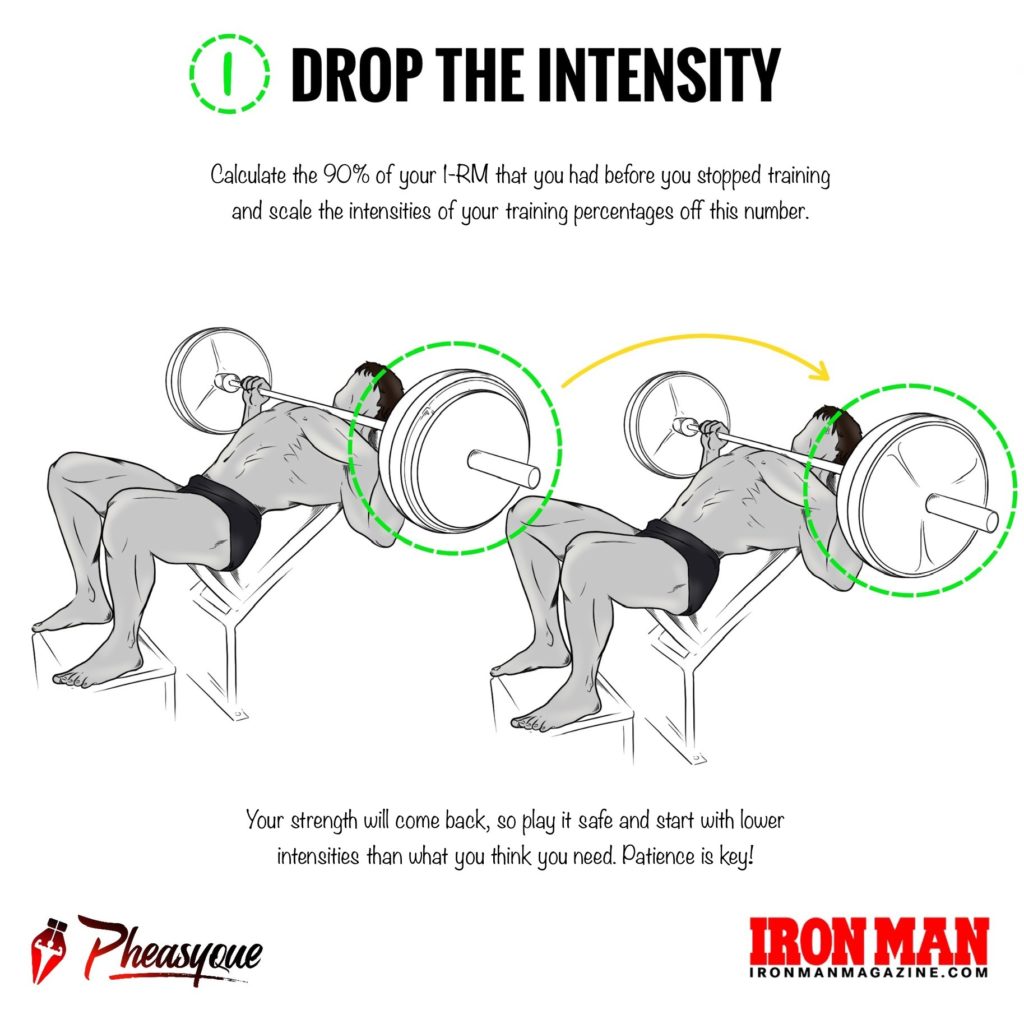
2) Go easy on volume: For accessories, stay lighter, and work on simply achieving quality reps. We like to recommend using Reps in Reserve (RIR) for controlling intensities on exercises, suggesting staying between 2-4 reps shy of failure during the first month of retraining. Staying lighter with accessories helps mitigate fatigue accumulation!
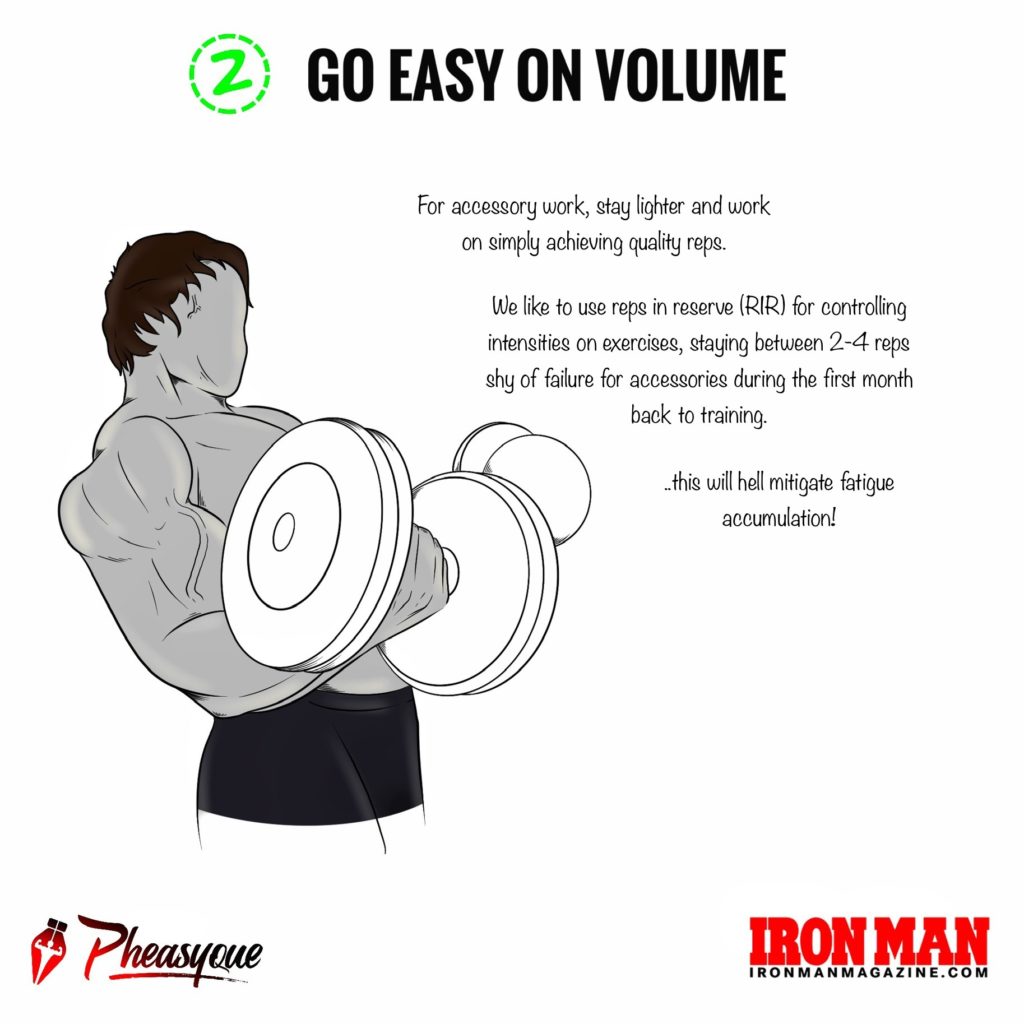
3) Don’t chase soreness: Excessive muscle soreness (DOMS) is counterproductive when returning to training. In research, DOMS has continually been linked to decreased performance across the board, so chasing soreness is counterintuitive when energy should be spent on rebuilding a foundation.
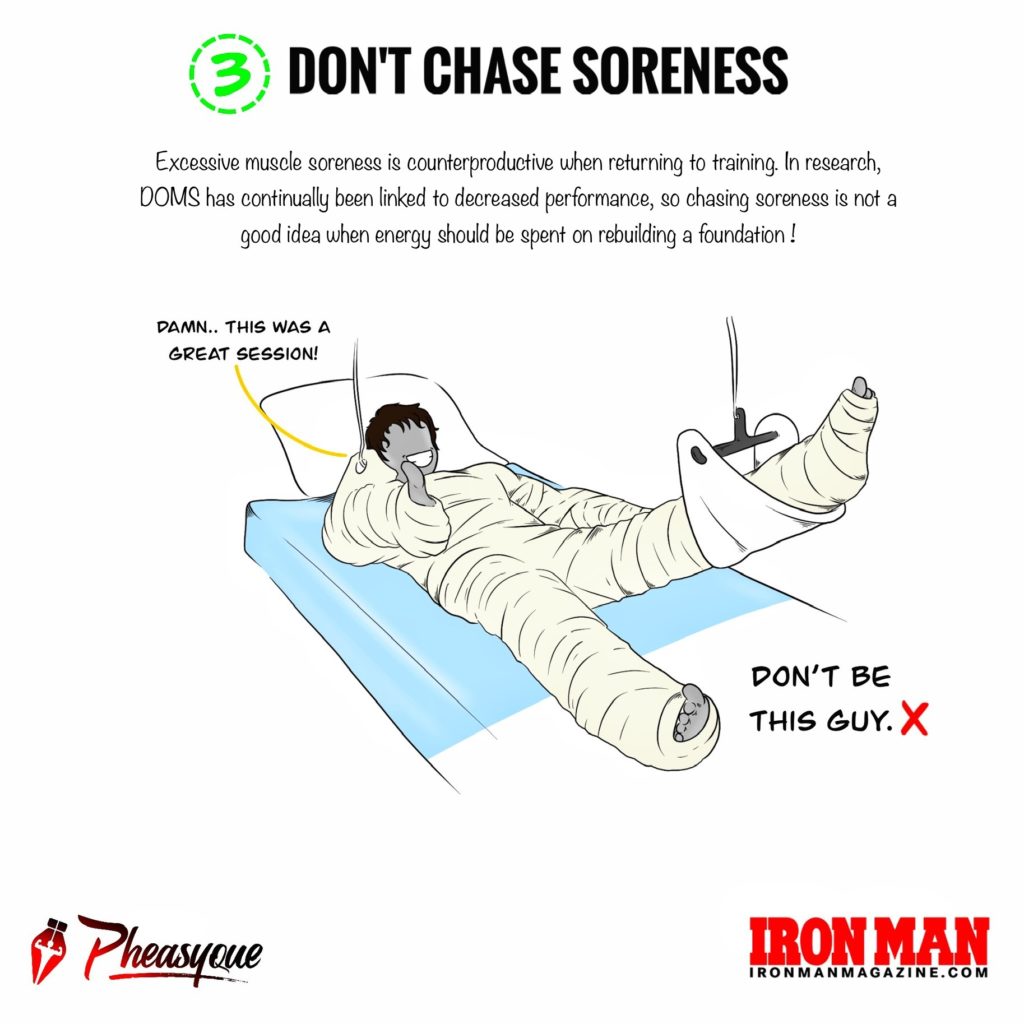
When in doubt, be conservative with your training and work to recover to your best abilities to limit excessive soreness, especially in the first four weeks back to training.
How you should approach your nutrition during your comeback:
Obviously, nutrition is just as important as training when it comes to maximizing your training performance, therefore making sure you’re eating the right amount of nutrients is mandatory during this period as well. Generally speaking, 3 are the scenarios we can end up with, after a period of detraining:
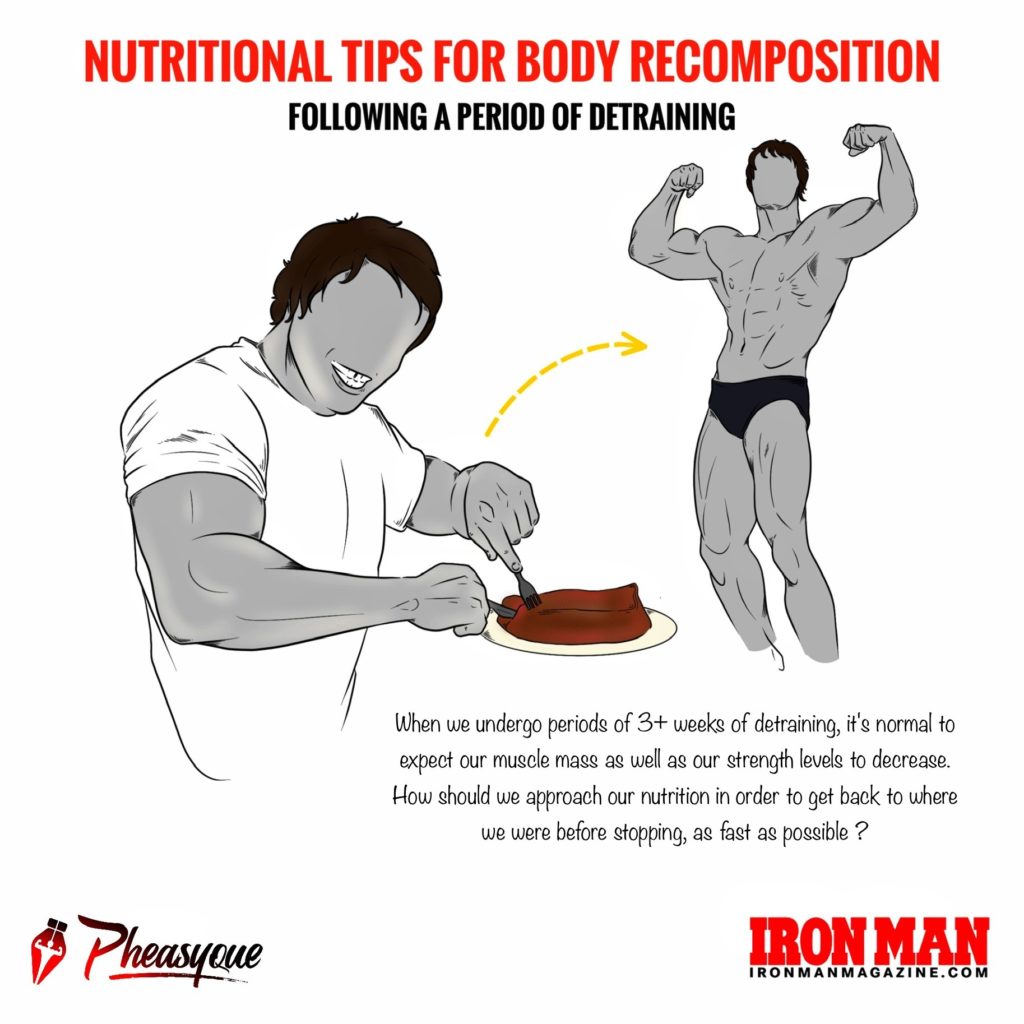
1) Muscle Loss: You’ve probably felt demotivated to diet and/or you haven’t had much appetite due to a decrease in energy expenditure. As a result, you’re looking at more than expected muscle loss.
What to do: Start rebuilding the habits that took you to where you were when you stopped training, going at your own pace. Make an extra effort to increase your protein intake (2.2g of protein per kg of bw/1g x lb of BW), keeping your total calories at your estimated maintenance or even a slight surplus to facilitate your strength gains.
2) Maintained Muscle: You’ve been able to maintain good dietary habits even during a detraining period
What to do: Keep doing your thing. If you’ve been able to maintain good habits even during a period of detraining, that means it’s no longer an effort for you, but a lifestyle. Stick to what you’re doing!
3) Gained more fat: You’ve likely over-indulged in high caloric foods (especially containing fats and carbohydrates) while exercising very little.
What to do: If you want to get back on track on your fitness journey, consider increasing your protein intake (1g/lb of bodyweight or 2.2g x kg of body weight ) to increase satiety while providing the right nutrients to rebuild muscle, while slightly decreasing your total caloric intake, to lose the fluff gained during this period!
Okay but how quickly can I return to my previous strength levels?
Now that we’ve gone over the training & nutritional recommendations, I would like to finish this article with some timeline expectations. Although it’s hard to offer a concrete timeframe for how much time you need to regain lost muscle, it is still a good idea to provide some guidelines, especially when science backs it up!
When it comes to getting back to your previous size and strength, we at Pheasyque like to use the Half The Time Rule:
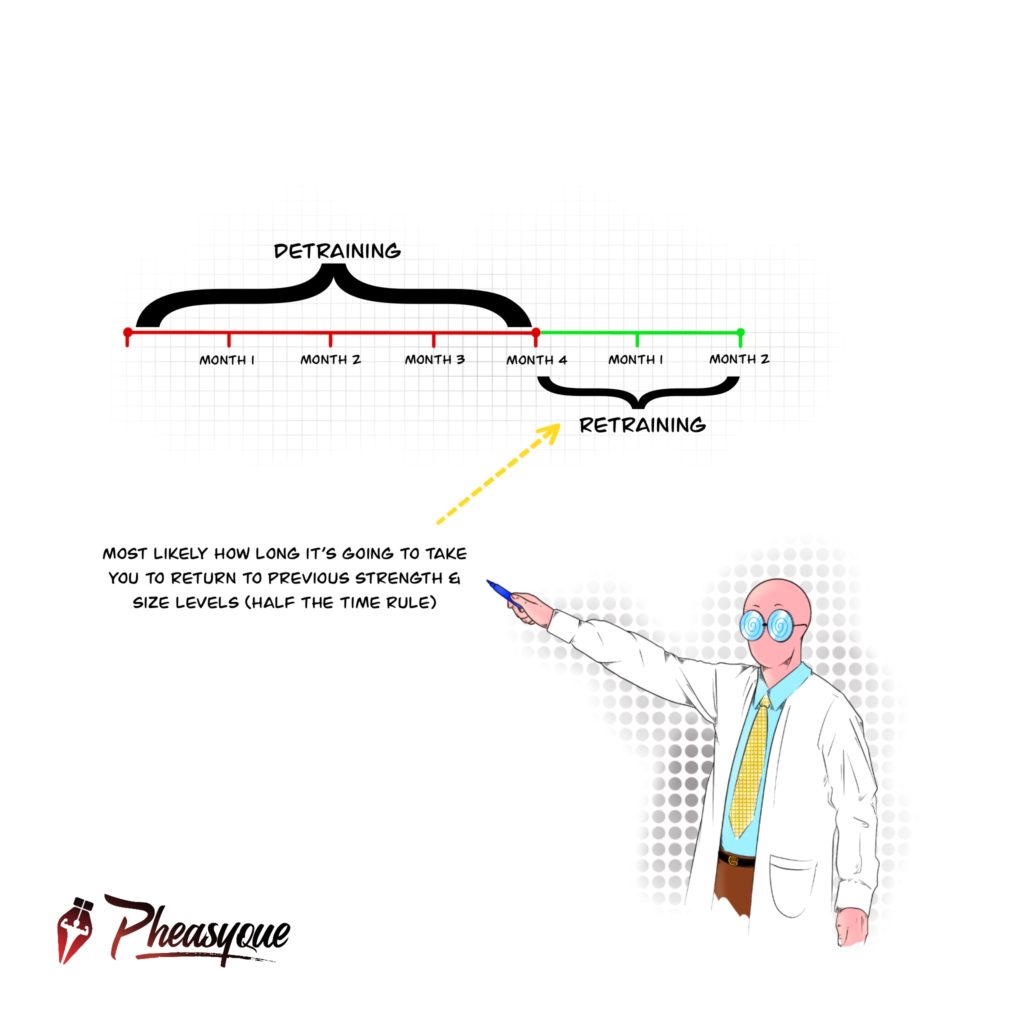
Essentially, you take the total time where a stop or change in training has occurred, then halve it to gain a better understanding of when you’ll likely return to your baseline levels, before the change/ stop in training occurred. Stopped training for 4 months? You’ll likely get back to your previous strength levels in two months if you take the right approach (following these guidelines!)
This rule won’t work 100% of the time, but it can provide some baseline metrics.
1) For example, when more time is taken off completely off training (9+ months/1+ years), then it will be harder to account for total losses of muscle, strength, and other performance indicators.
2) Otherwise, when changing the stimulus (like going from weights to bodyweight training) on the period of detraining can help preserve muscle mass better, when compared to a complete cessation of training.
3) Changes in dieting will obviously matter too, so eating a good mix of the right nutrients (especially proteins) can help speed up the process!
Author
Eugen Loki ACE CPT
@pheasyque
pheasyque.com






















You must be logged in to post a comment Login